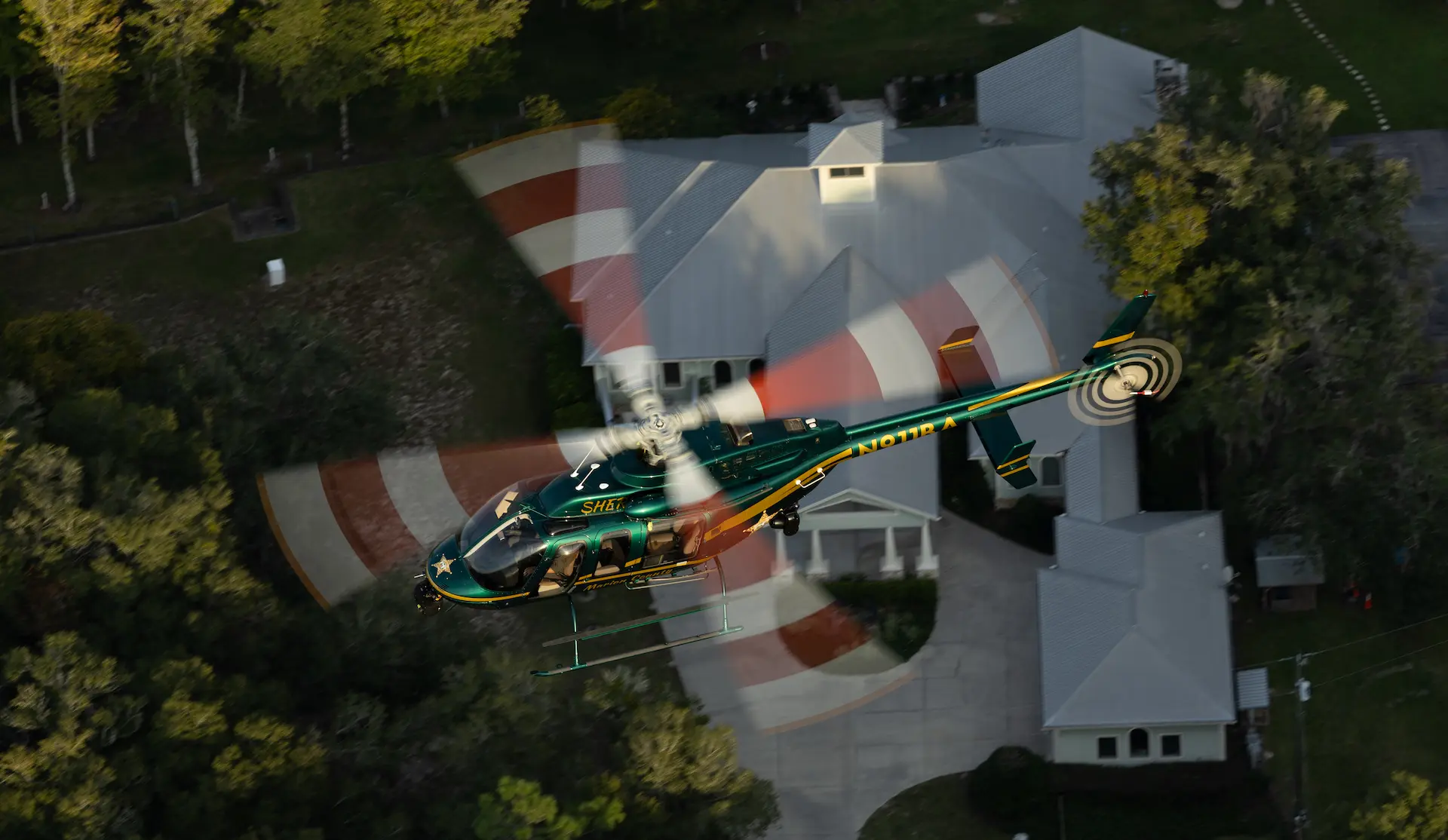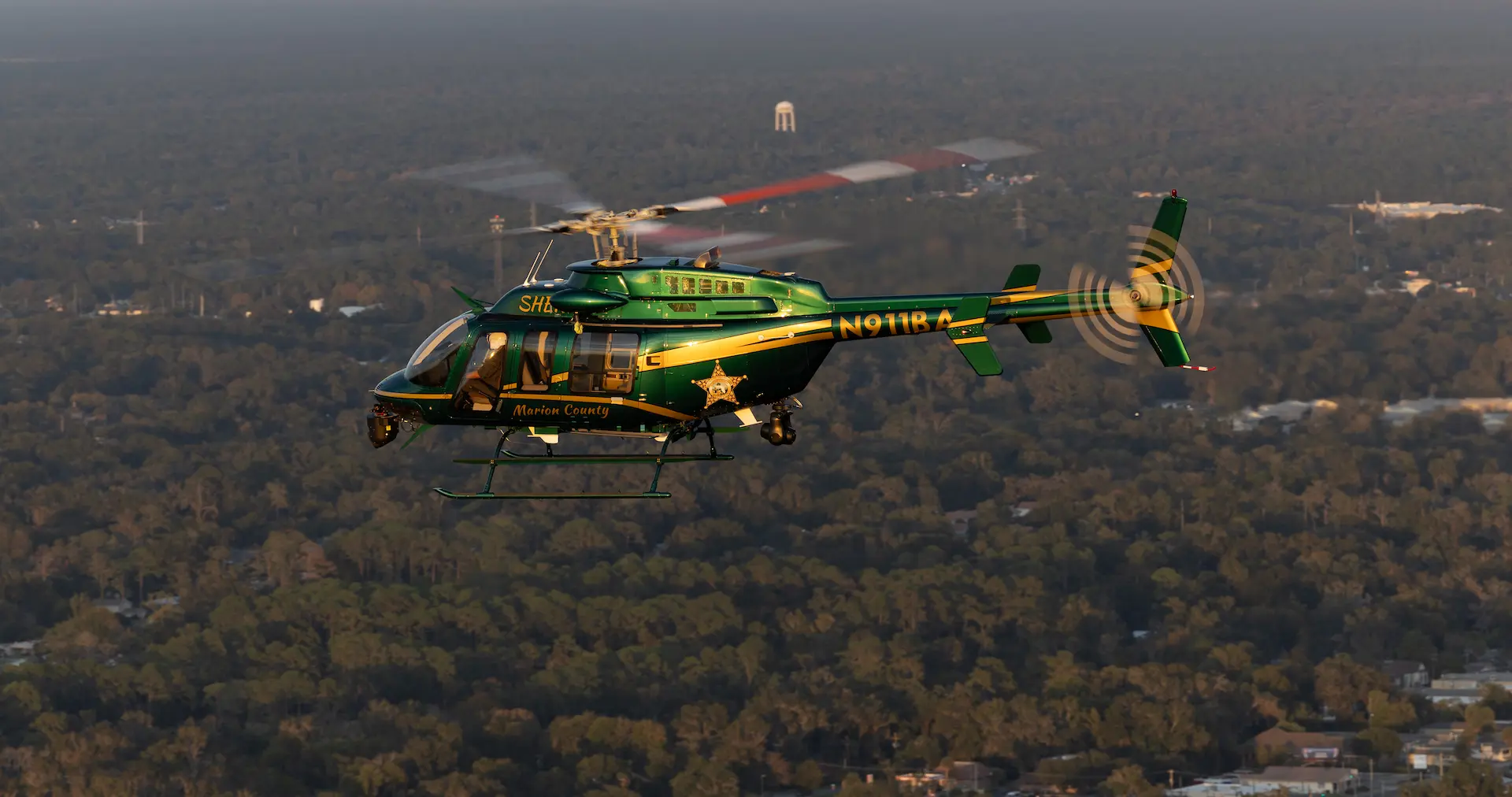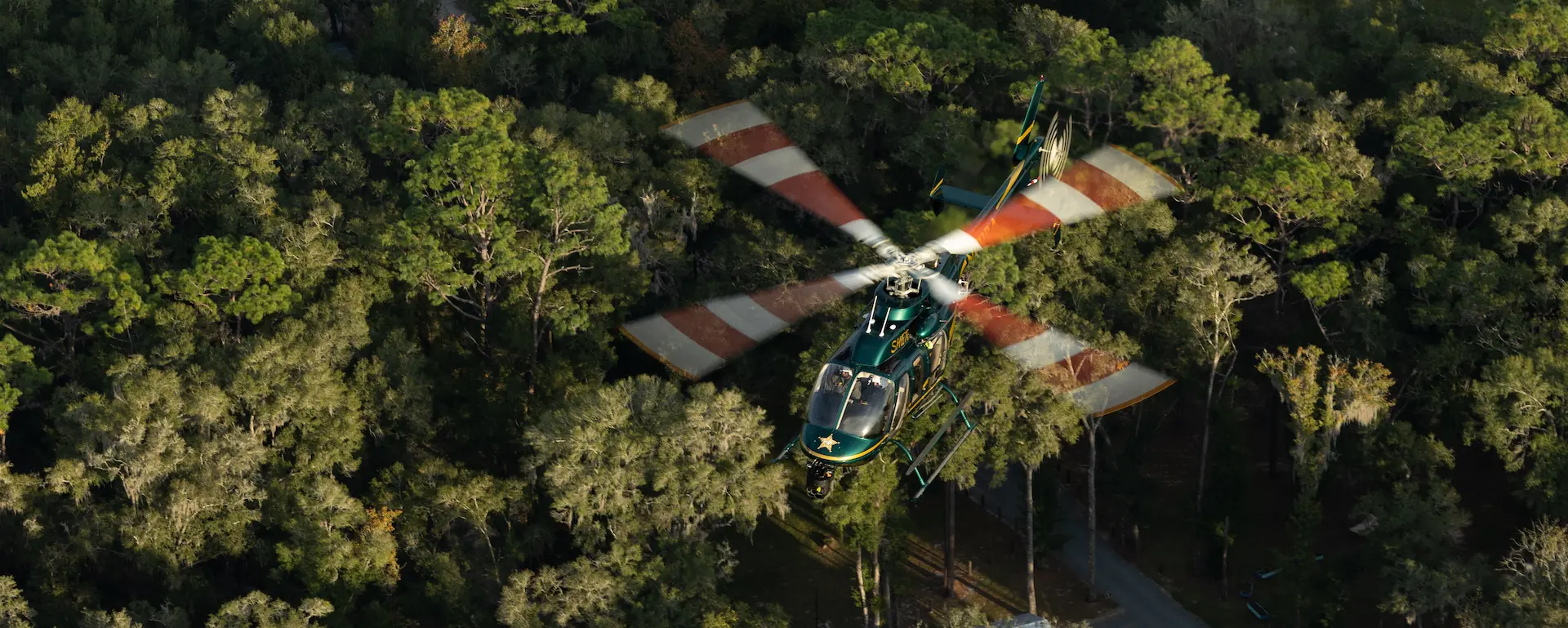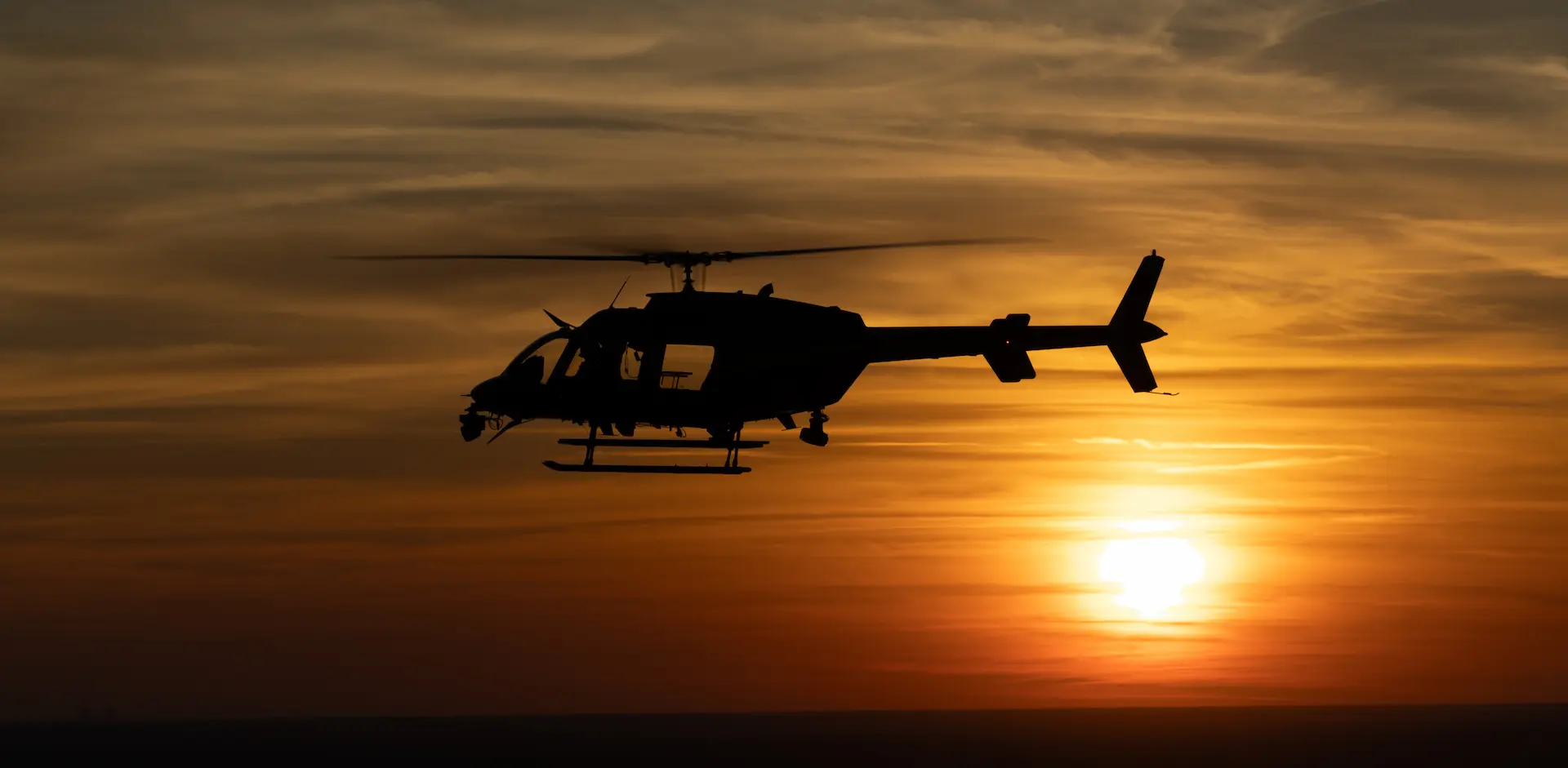Marion Count in Florida is home to a diverse range of people and industries. Responsible for an area of 1,662 square miles with around 400,000 people, the Marion County Sheriff’s Office has a unquestionable need for an effective aviation unit and the addition of a pair of Bell 407s provides a significant boost to its aerial capability.

Growth in Ocala, Florida has been significant over the last few years, and it continues unabated. “We have a constant influx of people, both
as new residents and tourists,” reported Chief Pilot Darren Bruner, Officer in Charge of the Marion County Sheriff’s Office (MCSO) aviation
unit. He pointed out that the area has several large new warehousing and distribution centers, a large and growing senior community of
retirees and is referred to as the ‘horse capital of the world’, boasting over 400 thoroughbred farms and training centers. “As the County
grew, we had to grow with it and that meant increased capability and more modern aircraft,” noted Brunner. “The more the County grows, the
busier we are because along with growth comes an increase in crime.”
Need for Change
Since the mid-90s, the MCSO has operated OH-58 Bell Kiowas to fulfil its aerial law enforcement role but it now faces increasing maintenance and more difficult parts sourcing to keep the aging ex-military machines flying. Two Kiowas are mission-capable, while a third was recently grounded and cannibalized for spares after the discovery of serious corrosion. Often, one Kiowa has been under maintenance or repair at any given time, leaving just one aircraft to fulfil the aviation unit’s patrol and search missions. A Bell TH-67 (206B) ex-Army trainer was subsequently added to the fleet, which gave the aviation unit the opportunity to conduct firefighting operations, as Bruner explained. “We were always looking to expand on what we could do and also knew that the OH-58s would not be around forever, as the Army is not supporting them any longer.” The TH-67, however, crashed during a firefighting mission just over a year later.
Bruner remarked that the TH-67 was small and only capable of operating single-pilot on firefighting missions, with a small bucket. “We decided to turn that unfortunate accident into a positive opportunity because it highlighted things that we could do better, and we knew that we were going to do more than just law enforcement. We were also going to be firefighting and the OH-58s were just not strong enough with all the extra equipment we’d put on, so we went to the next best thing that we could afford, which was a Bell 407.” “We can carry more water than the 67 and we could still outfit it with the latest and greatest technology at the time; the FLIR 380-HDc.”

Acquiring an FAA certificated aircraft like the 407 opens up a range of mission possibilities that the restricted category ex-military machines are not permitted to conduct. “The 407 is an excellent single-engine aircraft. It has a lot of power so we can lift 8-900lbs of water and also have an additional crewmember on board to assist with different safety precautions, so it has turned into a really good multi-mission aircraft,” Bruner commented. The County Commission went in with the Sheriff’s Office to help acquire the 407 after a review of the TH-67 accident led to a determination that firefighting and rescue hoisting were desired capabilities going forward. Bruner stressed that a major benefit to the unit is the unstinting support of Sheriff Billy Woods and the county commissioners. “We have a very good working relationship with the county commissioners who are very supportive, both of us and the Sheriff.”
Bell 407
The extra performance of the 407 allowed the inclusion of a hoist, a capability that was lacking when the 67 crashed, resulting in hours of delay in recovering pilot Sgt. John Rawls. “Forestry actually had to come and cut a road in through the thick undergrowth to get to him and it took forever,” Bruner advised. “If we had had a hoist, we could have dropped a firefighter down to him, brought him back up and landed on a road somewhere so he could get help.” Considering the extended rescue timeframe, it is extremely fortunate that Rawls’ injuries, although severe, were not life-threatening.

The MCSO’s first 407 arrived in January 2018 after Aero Brigham LLC of Decatur, Texas sourced a used aircraft and conducted a complete rebuild, law enforcement fit out and system integration over six or seven months. It arrived at the Sheriff’s Office already equipped with hoist, camera and firefighting capability, ready for immediate commencement of training and service. Bruner commended Aero Brigham on their standard of work and subsequent support, adding that it led to them being the sole choice of provider when it came to the acquisition of a second 407. Priority-1 Air Rescue was engaged to train the Sheriff crews in hoist operation, while MCSO Capt. Don Standridge – a certified flight instructor with extensive firefighting experience – provided training in Bambi-bucket firefighting operations, with additional courses conducted by the Forest Service. All crewmembers are now dual trained as both hoist pilot and hoist operator and in firefighting, with Brunner citing the high quality and range of extra training as a major benefit of the 407’s introduction.
More Crew and Another Aircraft
Although surveillance could be carried out with the OH-58s, the 407 allows the carriage of other personnel in the rear – such as a detective, K-9 officer or the sheriff – who can be delivered to a scene or view onboard screens in the rear cabin to gain a complete picture of the camera view and overall situation. The 407 also enables check rides to be carried out with an FAA examiner in-house without the need to hire a certificated aircraft from elsewhere and eliminates the need to fly a minimum extra three familiarity hours in that machine prior to the check ride. As the unit’s annual flight time continues to ramp up, any savings that can be made from such economies are of real value and the annual total is currently around 1,200 hours, with the very real probability of a continued increase as the population and resultant crime figures grow. The decision to get used aircraft instead of brand-new was a prudent one, as it saves a great deal of money. As Bruner pointed out, “If you look, you can find really good second-hand aircraft with low hours, and you can still put all the latest equipment into a used airframe. Plus, we have an excellent maintenance staff.”

After the grounding of the third OH-58, the aviation unit went back to the MCSO and the County in October 2022 to request a second 407. The additional machine will help cover increased demand from continuing growth in the county and provide dispatch reliability for instances when one 407 was down for maintenance or other AoG (aircraft on ground) occurrences. The unit has demonstrated its additional capabilities with the 407 over the last five years or so, with firefighting and several hoist rescues but there have been a few occasions when the 407 would have been a very useful asset but was down for maintenance. The case for an extra machine was strengthened even further when a hurricane necessitated flying the sole 407 slightly beyond its due maintenance schedule, aside from which, if the only 407 is deployed on an emergency or disaster relief mission, it leaves the county without an available platform with its capabilities.
To avoid building up too many hours on a single aircraft, the OH-58s are still being flown as mission aircraft alongside the 407 and Bruner acknowledged, “The 407 does burn more fuel but we try to be proactive and fly a minimum of three hours every day or night. When the ground patrol units hear us on the radio, they know we’re in the air and they’re more likely to call on us for things that they might not if we were on standby on the ground. By rotating all the mission aircraft, we spread the workload over three airframes.” With the addition of a second 407, the fleet will now consist of just one 58 alongside the two newer machines. The aircraft are all maintained in a mission-ready condition so if the 58 is flying and a mission requiring the 407 comes in, it is relatively quick and simple to return to base and switch machines. “The OH-58 is great for training and searches, but it just can’t match what we can do now with the 407 in those other mission roles,” commented Bruner.
 Equipped
to Serve
Equipped
to Serve
A second, slightly older but lower time used 407 was subsequently acquired in Mexico and modified by Aero Brigham to be almost identical to the original machine, but with the addition of floats. It arrived at the MCSO late in 2023 after delays caused by equipment and parts shortages that were beyond Aero Brigham’s control. Enhancing redundancy, the 407s each have their own 300lb Breeze-Eastern hoist and Bambi-bucket firefighting equipment. The standard doors have been replaced with sliding door kits on both sides to aid in hoist deployment, TrakkaBeam searchlights are fitted, while radios are Technisonic for law enforcement and Garmins for primary and backup flight comm’s.
Although the 407s both carry the original factory analogue instrumentation, Macro-Blue touchscreens are installed for the mission screens – a 12-inch for the moving map (a Shotover augmented reality system integrated into the FLIR), a larger screen for the FLIR monitor and a screen at the rear cabin for training, searches or any other purpose deemed necessary. The newest 407 came with a brand-new FLIR 380-X and the unit’s original two 380-HDc FLIRs have been upgraded to the 380-X specification, bringing a ‘blended imagery’ feature that can combine the different FLIR sensor outputs to maximize detail and information on the operator’s screen, something Rawls described as a ‘wonderful’ addition.
 The
MCSO aviation unit has been so successful in demonstrating its benefits and capabilities with the Bell 407 that budget has already been
allocated for a third example in 2025. “Our wishes for that one is that it be used for training, firefighting and hoisting, so we want it to
be a little bit lighter than the first two, but that conversation has yet to take place and the final say will be up to the Sheriff,” stated
Bruner. He commented that the OH-58 was unlikely to be retired when a third 407 enters service as the old bird is an excellent training
platform for new pilots and to allow post-solo pilots to build time in a more cost-effectively. “Also, it reduces the risk of something
happening to our mission aircraft if there’s an accident or incident in the 58,” he said.
The
MCSO aviation unit has been so successful in demonstrating its benefits and capabilities with the Bell 407 that budget has already been
allocated for a third example in 2025. “Our wishes for that one is that it be used for training, firefighting and hoisting, so we want it to
be a little bit lighter than the first two, but that conversation has yet to take place and the final say will be up to the Sheriff,” stated
Bruner. He commented that the OH-58 was unlikely to be retired when a third 407 enters service as the old bird is an excellent training
platform for new pilots and to allow post-solo pilots to build time in a more cost-effectively. “Also, it reduces the risk of something
happening to our mission aircraft if there’s an accident or incident in the 58,” he said.
Operations
The unit flies directed patrols as well as dealing with any calls for service and – although not routinely covering the entire county area – it does cover any area of high reported crime in the county and not just the municipality of Ocala city. The size of the county can mean significant transit times so the unit tries to be strategic about operating where it can be most productive. “Statistics have shown that by our presence alone we reduce crime,” Bruner remarked. Daytime sorties are typically flown at 700 to 1,000ft and night operations are conducted on NVGs at around 2,000 to 3,000ft. According to Bruner, the nature of service calls to the unit varies and every night can bring something different or unexpected. Typically, though, calls consist of frequent domestic and battery incidents, searches for missing aged or young persons, vehicle and foot pursuits, occasional robberies and now occasional firefighting assists during every fire season. “We might not be dropping water on every fire call, but the FLIR means we can look for hot spots or assist with fire mapping,” he noted.

Bruner explained that the unit’s coverage is not 24/7, with an 8 a.m. to 4 p.m. day shift operating from Monday to Friday. This is
supplemented by a 4 p.m. to 4 a.m. night shift, seven days a week and during the uncovered periods, the crews are on call. It is hoped that
the coverage will eventually become 24/7 but that depends on sufficient staffing levels, as Brunner explained. “The advantage of two pilots
on a shift is that we can cover any absences with a part-time TFO in the left seat, whereas at current staffing levels we’d have to go to
one pilot per shift to get 24-hour coverage.” The unit currently has five pilots – with one part-time pilot and a volunteer pilot – and two
TFOs that are pilots-in-training, while an additional seven part-time TFOs are on call from the MCSO’s two companies of ground units and
maintenance needs are fulfilled by two full-time maintenance personnel. “We always try to fly with two pilots whenever we can, because that
covers pilot and TFO duties as well as hoisting, if necessary,” he advised.
Future
Regarding future fleet possibilities, Bruner commented, “With the OH-58s our missions were law enforcement patrol and surveillance but since we started with the 407, we have added firefighting and hoist rescues to our core missions. Because of that I don’t think that we will ever go to anything less than a 407 for our mission aircraft.” He opined that the continued growth in the county could feasibly see the unit transition to a larger machine such as the Bell 429 in the future, although maybe not for some years yet. “We now have the biggest single-engine airframe that Bell makes and the 429s are bigger, twin-engine and IFR capable so in time they’d probably replace the 407s.” The unit’s facility will also have to expand in the near future as a third 407 will not fit into the hangar, as the model takes up more space than the OH-58 with its semi-rigid rotor system.
Bruner came from a military, non-aviation background to the MCSO and thinks he has the best job going. He commented, “Not only do we get paid to fly helicopters, but we also get to fly them in the way we do. We chase bad guys, help our colleagues on the ground chase and catch bad guys, do firefighting and rescues.” He remarked that the pilots’ common deputy-sheriff background made for a deeper understanding of the mission and its needs and enabled a much closer working relationship with ground units. “They know us personally because we’ve worked calls with them. Sometimes we’ll go to briefings with them at night and we’ll educate them about the weather and how it limits us. We can get fog in the morning and evening that can stop us flying, and at certain times of year we can get thunderstorms or hurricane weather, so we show them that, aside from the safety issue, the camera is ineffective in fog and cloud.”

Rawls has been with the MCSO since 1998, with around 1,200 hours of military flight time. He is a unit trainer and command pilot and
appreciates that his job as an MCSO pilot combines his law enforcement background with his lifelong interest in aviation. “I love it out
here. This is the best job that you can have and not get in trouble,” he quipped. “There’s no other job outside the military that you can go
out and do what we do and get paid for it.” He enjoys the power, extra features and modernity of the 407, although he did state that he
would much prefer the added safety inherent in a twin-engine aircraft like the 429. He also praised the OH-58 for its simplicity and ease of
piloting, while acknowledging that it is somewhat underpowered for the MCSO’s needs.
Everyone on the aviation unit is a deputy sheriff who has worked on the road for a minimum of two years and Bruner stated that the law enforcement experience is invaluable to a pilot, something that speaks to the wisdom of in-house pilot selection and training. One or two pilots came, like Rawls, from a military flying background but still require deputy-sheriff experience before joining the unit’s pilot roster. New, unlicensed pilot trainees to the unit all must undergo TFO training before progressing to pilot training, ensuring that not only are they competent in the operation of all mission equipment, but that they are also comfortable and capable in the airborne environment. Trainees must then log a minimum of at least 450 hours flight time before they can be signed off as a unit pilot-in-charge and the unit has two part-time CFIs that conduct training from ab-initio to CPL.

Bruner is adamant that it is the personnel who have made the difference with the 407. “What makes it work is the people. None of this would
have been possible without the guys that work in this unit. Sure, the helicopter is a wonderful thing, but it isn’t going to do anything
unless these guys are working it. Every one of these guys here go out and work the aircraft every day, they go out and show how well it
works, they take every call seriously and they’re dedicated. They get angry at themselves if they don’t find what they’re looking for or
achieve what they set out to do.”
 HOME
HOME


